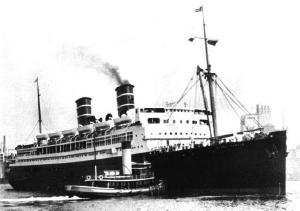SS Morro Castle (1930)
 |
|
| History | |
|---|---|
|
|
|
| Name: | Morro Castle |
| Namesake: | Morro Castle, Havana, Cuba |
| Owner: | Agwi Navigation Co, Inc |
| Operator: |
|
| Port of registry: | New York |
| Route: | New York City – Havana, Cuba |
| Builder: | Newport News Shipbuilding |
| Cost: | $4 million in 1930 |
| Christened: | March 1930 |
| Completed: | August 15, 1930 |
| Maiden voyage: | August 23, 1930 |
| In service: | August 15, 1930 |
| Out of service: | September 8, 1934 |
| Homeport: | New York |
| Identification: |
|
| Fate: | Caught fire and beached herself on September 8, 1934; later towed off and sold to breakers (Union Shipbuilding Co.) |
| Status: | Scrapped |
| General characteristics | |
| Tonnage: | |
| Length: | 508 ft (155 m) |
| Beam: | 70.9 ft (21.6 m) |
| Depth: | 39.0 ft (11.9 m) |
| Propulsion: |
|
| Speed: | 20 knots (37 km/h) |
| Capacity: | 489 passengers |
| Crew: | 240 crew |
| Notes: | sister ship: SS Oriente |
SS Morro Castle was an ocean liner of the 1930s that was built for the Ward Line for voyages between New York City and Havana, Cuba. The ship was named for the Morro Castle fortress that guards the entrance to Havana Bay. On the morning of September 8, 1934, en route from Havana to New York, the ship caught fire and burned, killing 137 passengers and crew members. The ship eventually beached herself near Asbury Park, New Jersey, and remained there for several months until she was towed off and scrapped.
The devastating fire aboard the SS Morro Castle was a catalyst for improved shipboard fire safety. Today, the use of fire-retardant materials, automatic fire doors, ship-wide fire alarms, and greater attention to fire drills and procedures resulted directly from the Morro Castle disaster.
On May 22, 1928, the U.S. Congress passed the Merchant Marine Act of 1928, creating a $250 million construction fund to be lent to U.S. shipping companies to replace old and outdated ships with new ones. Each of these loans, which could subsidize as much as 75% of the cost of the ship, was to be paid back over 20 years at very low interest rates. One company that quickly availed itself of this opportunity was the Ward Line (officially: the New York and Cuba Mail Steam Ship Company), which had been carrying passengers, cargo and mail to and from Cuba since the mid-19th century. Naval architects were hired by the line to design a pair of passenger and cargo liners to be named SS Morro Castle after the stone fortress and lighthouse in Havana and SS Oriente after Oriente Province in Cuba.
...
Wikipedia
